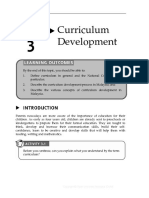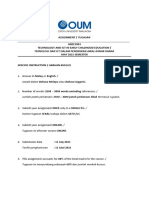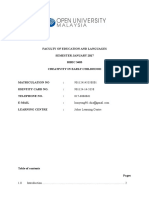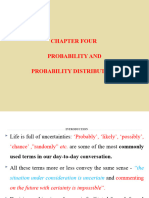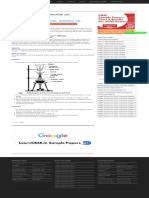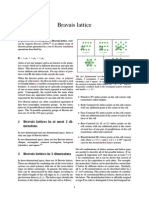Business Statistics: Fm/Bi/Hm/Tm/Ebm 1 2 3 3
Uploaded by
isuruerandaBusiness Statistics: Fm/Bi/Hm/Tm/Ebm 1 2 3 3
Uploaded by
isuruerandaPrepared by
H.R.Sampath
F M/ BI / HM/ T M/ E BM
1 2 3 3
Faculty of Management Studies
Sabaragamuwa University of Sri Lanka
Business Statistics
Probability
Probability means
In general probability is the chance something will happen. It will
expressed as fractions (1/3, 1/5, 2/7) or as decimals (0.66,0.20, 0.28)
between zero and one. Zero indicate that something will never
happen, a probability of 1indicates that something will always
happen.
Basic Concepts in Probability
An Event;
It is one or more of the possible outcomes of doing something
e.g. If we toss a coin, getting a tail would be an event and getting a head also an
event.
An experiment
The activity that generate an event is called experiment.
e.g. Tossing a coin
Sample space
The set of all possible outcomes of an experiment is called the sample space.
e.g. In tossing a coin, sample space is;
S = (Head, Tail)
Basic Concepts in Probability cont
Mutually exclusive events;
Events are said to be mutually exclusive if one and only one of them can take
place at a time.
e.g. If we toss a coin, getting a tail or head is mutually exclusive events.
Collectively exhaustive list
When a list of the possible events that can result from an experiment includes
every possible outcome, the list is said to be collectively exhaustive.
e.g. The list head and tail is collectively exhaustive.
Types of Probability
There are three basic ways of classifying probability.
Classical approach / priori probability
Relative frequency approach
Subjective approach
Classical Probability / Priori Probability
Classical probability defines the probability that an event will occur
as;
Here it is important that to calculate the probability, each of the
possible outcomes must be equally likely.
Classical approach also called priori probability because we can state
the answer in advance.
Probability of an event =
Number of outcomes
where the event occurs
Total Number of outcomes
Relatively Frequency of Occurrence
Here we define probability as either;
The observed relative frequency of an event in a very large number
of trials.
The proportion of times that an event occurs in the long run when
condition are stable.
Using Relatively Frequency of
Occurrence Approach
This method uses the relative frequencies of past occurrences as
probabilities.
Here we determine how often something has happened in the past and
use that figure to predict the probability that will happen again in the
future.
Example
Suppose an insurance company knows from past actuarial data that of
all males 50 years old, about 55 out of every 10,000 will die within a
one year period. Using this method, the company estimates the
probability of death for that age group;
Limitation of using Relative Frequency
One of the main difficulty with the relative frequency approach is that
people use it without evaluating a sufficient number of outcomes.
Subjective probability
This method was introduced by Frank Ramsey in 1926. Further developed by
Bernard Koopman, Richard Good and Leonard Savage.
Subjective probabilities are based on the beliefs of the person making the
probability assessments.
It can be define as the probability assigned to an event by an individual, based on
whatever evidence is available. This evidence may be in the form of relative
frequency of past occurrences or it may be just an educated guess.
According to this method, two people faced with the same evidence could easily
come up with quite different subjective probabilities for the same event.
Conditional probability
The conditional probability of an event B is the probability that the event B will
occur subject to the condition A has already occurred.
This probability is written P(B|A), notation for the probability of B given A.
Formula;
P(B/A) =
P(A B)
P(A )
Marginal and Joint probability
Marginal Probability
Probability of any one single event used to define the contingency table is a marginal
probability.
J oint Probability
Probability of two or more events is as referred to as a joint probability.
Exercise
Marketing department of a company has recently conducted as survey of 200
consumers of their products to obtain a sex and age profile of their customers. The
results obtained are shown in the following table, which is a contingency or cross-
classification table.
Sex
Age (Years)
< 20 (T) 20 - 55 (M) > 55 (O) Total
Male (M) 25 30 50 105
Female (F) 20 35 40 95
Total 45 65 90 200
Exercise cont
You are ask to compute following probabilities;
Marginal probability of ;
i. P(T) ii. P(M) iii. P(O)
Joint probability of;
i. P(T and F) ii. P(A and M) iii. P(O and M)
Conditional probability of;
i. P(T/F) ii. P(A/M) iii. P(M/O)
Exercise
A company has submitted quotation for two separate contracts, A and B. The
company feels that it has 80% chance of winning contract A and 70% chance of
loosing contract B. Given that it wins contract B, the company believes it has 40%
chance of winning contract A.
i. What is the probability that the company will win at least one of the two
contracts?
ii. If the company loss contract B, what is the probability that it will not win
contract A?
You might also like
- Assignment May 2020 Semester: Subject Code: ESE633 Subject Title: Statistics in Education Level: Master100% (1)Assignment May 2020 Semester: Subject Code: ESE633 Subject Title: Statistics in Education Level: Master19 pages
- ICT-centered Teaching Learning: Presented byNo ratings yetICT-centered Teaching Learning: Presented by99 pages
- HBEC2603 Teaching English To Young LearnersNo ratings yetHBEC2603 Teaching English To Young Learners7 pages
- EDUC 1163 - Social Studies For The Young ChildNo ratings yetEDUC 1163 - Social Studies For The Young Child16 pages
- The Evolution of Technology in EducationNo ratings yetThe Evolution of Technology in Education9 pages
- ECE223.ASSIGNMENTS Children - Special.Needs PDFNo ratings yetECE223.ASSIGNMENTS Children - Special.Needs PDF8 pages
- Assignment HMEF5043 - V2 Educational Psychology January 2021 SemesterNo ratings yetAssignment HMEF5043 - V2 Educational Psychology January 2021 Semester10 pages
- Assignment / Tugasan HBEC3903 Technology and Ict in Early Childhood Education / May 2021 SemesterNo ratings yetAssignment / Tugasan HBEC3903 Technology and Ict in Early Childhood Education / May 2021 Semester9 pages
- ICT Technologies To Carter To Needs of Children With Special NeedsNo ratings yetICT Technologies To Carter To Needs of Children With Special Needs37 pages
- Development of Malaysian School CurriculumNo ratings yetDevelopment of Malaysian School Curriculum22 pages
- Hbec2503 Mathematics in Early Childhood Education PDFNo ratings yetHbec2503 Mathematics in Early Childhood Education PDF7 pages
- Assigment Elementry Statistics Sbst1303No ratings yetAssigment Elementry Statistics Sbst130311 pages
- CE3404 QB 01 2 MARKS - by LearnEngineering - inNo ratings yetCE3404 QB 01 2 MARKS - by LearnEngineering - in17 pages
- Sugar Crystallisation: Look For The Devil in The Details. Part 1No ratings yetSugar Crystallisation: Look For The Devil in The Details. Part 112 pages
- Test Method RC 20101 Design of Asphalt Mixes Marshall MethodNo ratings yetTest Method RC 20101 Design of Asphalt Mixes Marshall Method4 pages
- Solution Manual for Single Variable Essential Calculus Early Transcendentals, 2nd Edition - Full Book Is Now Available For Download100% (2)Solution Manual for Single Variable Essential Calculus Early Transcendentals, 2nd Edition - Full Book Is Now Available For Download24 pages
- Journal of Applied Mechanics: Finite Elements For Structural Analysis. by William WeaverNo ratings yetJournal of Applied Mechanics: Finite Elements For Structural Analysis. by William Weaver1 page
- Available Moisture For Different Major Soil CategoriesNo ratings yetAvailable Moisture For Different Major Soil Categories65 pages
- Answer in Molecular Physics Thermodynamics For Clara Ogu #123865No ratings yetAnswer in Molecular Physics Thermodynamics For Clara Ogu #1238651 page
- To Prepare Ferric Hydroxide Sol - Chemistry Practical Class 12 - Learn CBSENo ratings yetTo Prepare Ferric Hydroxide Sol - Chemistry Practical Class 12 - Learn CBSE1 page
- Philippine Inventions Science Technology Society Videophone: Biasura, Jhazreel Mae N. Bsa 2BNo ratings yetPhilippine Inventions Science Technology Society Videophone: Biasura, Jhazreel Mae N. Bsa 2B2 pages
- Assignment May 2020 Semester: Subject Code: ESE633 Subject Title: Statistics in Education Level: MasterAssignment May 2020 Semester: Subject Code: ESE633 Subject Title: Statistics in Education Level: Master
- Assignment HMEF5043 - V2 Educational Psychology January 2021 SemesterAssignment HMEF5043 - V2 Educational Psychology January 2021 Semester
- Assignment / Tugasan HBEC3903 Technology and Ict in Early Childhood Education / May 2021 SemesterAssignment / Tugasan HBEC3903 Technology and Ict in Early Childhood Education / May 2021 Semester
- ICT Technologies To Carter To Needs of Children With Special NeedsICT Technologies To Carter To Needs of Children With Special Needs
- Hbec2503 Mathematics in Early Childhood Education PDFHbec2503 Mathematics in Early Childhood Education PDF
- Sugar Crystallisation: Look For The Devil in The Details. Part 1Sugar Crystallisation: Look For The Devil in The Details. Part 1
- Test Method RC 20101 Design of Asphalt Mixes Marshall MethodTest Method RC 20101 Design of Asphalt Mixes Marshall Method
- Solution Manual for Single Variable Essential Calculus Early Transcendentals, 2nd Edition - Full Book Is Now Available For DownloadSolution Manual for Single Variable Essential Calculus Early Transcendentals, 2nd Edition - Full Book Is Now Available For Download
- Journal of Applied Mechanics: Finite Elements For Structural Analysis. by William WeaverJournal of Applied Mechanics: Finite Elements For Structural Analysis. by William Weaver
- Available Moisture For Different Major Soil CategoriesAvailable Moisture For Different Major Soil Categories
- Answer in Molecular Physics Thermodynamics For Clara Ogu #123865Answer in Molecular Physics Thermodynamics For Clara Ogu #123865
- To Prepare Ferric Hydroxide Sol - Chemistry Practical Class 12 - Learn CBSETo Prepare Ferric Hydroxide Sol - Chemistry Practical Class 12 - Learn CBSE
- Philippine Inventions Science Technology Society Videophone: Biasura, Jhazreel Mae N. Bsa 2BPhilippine Inventions Science Technology Society Videophone: Biasura, Jhazreel Mae N. Bsa 2B













